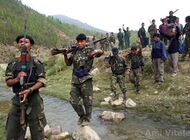Mahanan Civil War
| Mahanan Civil War | |||||||
|---|---|---|---|---|---|---|---|
 Pro-democrat soldiers crossing a stream in the southern Nuragara Province, 1992 | |||||||
| |||||||
| Belligerents | |||||||
| Royalist Forces | Republican Forces | ||||||
| Commanders and leaders | |||||||
|
|
| ||||||
| Units involved | |||||||
|
|
Supported by: | ||||||
| Strength | |||||||
| 50,000 | 95,000 | ||||||
| Casualties and losses | |||||||
| 8,200 killed (guerrillas) | 4,500 killed | ||||||
The Mahanan Civil War was a protracted armed conflict that took place in Mahana from January 1992 to March 1993. It saw fighting between supporters of the monarchy, known as Misrans, and supporters of a new republic. The war led to the establishment of the Federal Democratic Republic of Mahana in 1993.
Overview
Background
The war began as increasing (at the time) authoritarianism of the monarchy as King Raju III attempts to preserve his legacy by keeping the monarchy alive in a time where growing desire by the population for democracy and cooperation with other Oriental states, two things the nation had not been doing. As well as this, Mahana during the 1970s, 80s and early 90s was in a period of deprivation as nations around it that had adopted parliamentary systems (See: Kotowari, Mekabiri) so demand for change had began to spread like wildfire. This lead to an uprising lead by a rebellion group which later became the Mahanan Congress, known as simply "Republicans" which had began to become a localised militia of soldiers. These soldiers had minimal training however the attacks began on small scale with surprise invasions of military bases and monarchic structures.